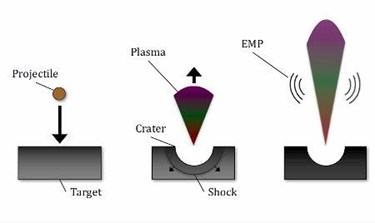Simulations Explain How Space Dust Impacts Generate EMPs
By Jof Enriquez,
Follow me on Twitter @jofenriq

Electromagnetic pulses (EMP) that can disrupt satellite electronics are caused by expanding plasma produced by hypervelocity impacts of space dust and debris, according to computer simulations made by researchers at Stanford University and Boston University.
"For the last few decades researchers have studied these hypervelocity impacts and we've noticed that there's radiation from the impacts when the particles are going sufficiently fast," said Alex Fletcher, a postdoctoral researcher at the Boston University Center for Space Physics. "No one has really been able to explain why it's there, where it comes from or the physical mechanism behind it."
More than half of satellite system failures are still unexplained, but scientists led by Sigrid Close, associate professor of aeronautics and astronautics at Stanford University, first suggested in 2010 that hypervelocity impact plasmas may be to blame for some cases. Close and colleagues theorized that these impacts create a plasma cloud that expands into the surrounding vacuum of space with a separated charge caused by the different mobilities of the electrons and ions, which, consequently, produces a strong electromagnetic pulse (EMP) that can cause catastrophic damage to spacecraft systems.
Fletcher worked with his adviser Close to verify the latter's theory by using a method called particle-in-cell simulation (specifically, a discontinuous Galerkin particle-in-cell technique), which allows them to model the plasma and the electromagnetic fields simultaneously. In their simulation, a piece of dust or orbital debris, upon impact, vaporizes and ionizes the target, creates a crater, and ejects a cloud of dust, gas and plasma. As the plasma expands into the vacuum, its density drops and it becomes collisionless.
At some point in the expansion of this collisionless plasma, the researchers assume that the electrons travel faster than the larger ions. It is this large-scale charge separation that produces the RF emissions.
"The idea is that there is an extremely rapid transition from a collisional to a collisionless state, allowing the electrons to separate en masse from the ions due to their higher mobility. This sets up an ambipolar field which pulls the electrons back and the ions forward. The coherent motion of the electrons is the source of the emission," explain Fletcher and Close in the study paper, published in AIP Physics of Plasmas.
The simulation “is definitely consistent with the theory and the little data we have from space,” said Close, who is planning to launch a cubesat called Morgana to further verify their findings, reports IEEE Spectrum.
In the meantime, the researchers want to use simulation data to quantify the radiation generated so they can assess the threat to satellites, and devise ways to protect satellites and spacecraft from meteoroids and orbital debris. They also plan for future simulations to take into account the dynamics of the dust particles that interact with the plasma produced by those hypervelocity impacts.
